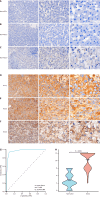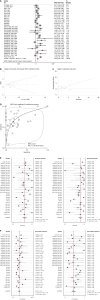Overexpression and clinicopathological significance of zinc finger protein 71 in hepatocellular carcinoma
- PMID: 40027564
- PMCID: PMC11866156
- DOI: 10.4254/wjh.v17.i2.101914
Overexpression and clinicopathological significance of zinc finger protein 71 in hepatocellular carcinoma
Abstract
Background: Hepatocellular carcinoma (HCC) is one of the most prevalent and aggressive forms of liver cancer, with high morbidity and poor prognosis due to late diagnosis and limited treatment options. Despite advances in understanding its molecular mechanisms, effective biomarkers for early detection and targeted therapy remain scarce. Zinc finger protein 71 (ZNF71), a zinc-finger protein, has been implicated in various cancers, yet its role in HCC remains largely unexplored. This gap in knowledge underscores the need for further investigation into the ZNF71 of potential as a diagnostic or therapeutic target in HCC.
Aim: To explore the expression levels, clinical relevance, and molecular mechanisms of ZNF71 in the progression of HCC.
Methods: The study evaluated ZNF71 expression in 235 HCC specimens and 13 noncancerous liver tissue samples using immunohistochemistry. High-throughput datasets were employed to assess the differential expression of ZNF71 in HCC and its association with clinical and pathological features. The impact of ZNF71 on HCC cell line growth was examined through clustered regularly interspaced short palindromic repeat knockout screens. Co-expressed genes were identified and analyzed for enrichment using LinkedOmics and Sangerbox 3.0, focusing on significant correlations (P < 0.01, correlation coefficient ≥ 0.3). Furthermore, the relationship between ZNF71 expression and immune cell infiltration was quantified using TIMER2.0.
Results: ZNF71 showed higher expression in HCC tissues vs non-tumorous tissues, with a significant statistical difference (P < 0.05). Data from the UALCAN platform indicated increased ZNF71 levels across early to mid-stage HCC, correlating with disease severity (P < 0.05). High-throughput analysis presented a standardized mean difference in ZNF71 expression of 0.55 (95% confidence interval [CI]: 0.34-0.75). The efficiency of ZNF71 mRNA was evaluated, yielding an area under the curve of 0.78 (95%CI: 0.75-0.82), a sensitivity of 0.63 (95%CI: 0.53-0.72), and a specificity of 0.82 (95%CI: 0.73-0.89). Diagnostic likelihood ratios were positive at 3.61 (95%CI: 2.41-5.41) and negative at 0.45 (95%CI: 0.36-0.56). LinkedOmics analysis identified strong positive correlations of ZNF71 with genes such as ZNF470, ZNF256, and ZNF285. Pathway enrichment analyses highlighted associations with herpes simplex virus type 1 infection, the cell cycle, and DNA replication. Negative correlations involved metabolic pathways, peroxisomes, and fatty acid degradation. TIMER2.0 analysis demonstrated positive correlations of high ZNF71 expression with various immune cell types, including CD4+ T cells, B cells, regulatory T cells, monocytes, macrophages, and myeloid dendritic cells.
Conclusion: ZNF71 is significantly upregulated in HCC, correlating with the disease's clinical and pathological stages. It appears to promote HCC progression through mechanisms involving the cell cycle and metabolism and is associated with immune cell infiltration. These findings suggest that ZNF71 could be a novel target for diagnosing and treating HCC.
Keywords: Enrichment analysis; Hepatocellular carcinoma; Immune infiltration; Immunohistochemistry; Zinc finger protein 71.
©The Author(s) 2025. Published by Baishideng Publishing Group Inc. All rights reserved.
Conflict of interest statement
Conflict-of-interest statement: The authors have no conflicts of interest to declare.
Figures







References
-
- Sung H, Ferlay J, Siegel RL, Laversanne M, Soerjomataram I, Jemal A, Bray F. Global Cancer Statistics 2020: GLOBOCAN Estimates of Incidence and Mortality Worldwide for 36 Cancers in 185 Countries. CA Cancer J Clin. 2021;71:209–249. - PubMed
-
- Wang Y, Deng B. Hepatocellular carcinoma: molecular mechanism, targeted therapy, and biomarkers. Cancer Metastasis Rev. 2023;42:629–652. - PubMed
LinkOut - more resources
Full Text Sources
Research Materials
Miscellaneous

